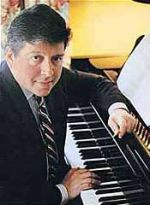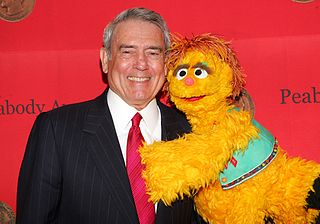
The Muppets are an American ensemble cast of puppet characters known for an absurdist, burlesque, and self-referential style of variety-sketch comedy. Created by Jim Henson in 1955, they are the focus of a media franchise, now owned by The Walt Disney Company, that encompasses television, film, music, and other media associated with the characters.

Sesame Street is an American long-running educational children's television series that combines live-action, sketch comedy, animation and puppetry. It is produced by Sesame Workshop and was created by Joan Ganz Cooney and Lloyd Morrisett. It is known for its images communicated through the use of Jim Henson's Muppets, and includes short films, with humor and cultural references. It premiered on November 10, 1969, to positive reviews, some controversy, and high viewership. It has aired on the United States national public television provider PBS since its debut, with its first run moving to premium channel HBO on January 16, 2016, then its sister streaming service HBO Max in 2020. Sesame Street is one of the longest-running shows in the world.

Sesame Workshop (SW), originally known as the Children's Television Workshop (CTW), is an American nonprofit organization that has been responsible for the production of several educational children's programs—including its first and best-known, Sesame Street—that have been televised internationally. Television producer Joan Ganz Cooney and foundation executive Lloyd Morrisett developed the idea to form an organization to produce Sesame Street, a television series which would help children, especially those from low-income families, prepare for school. They spent two years, from 1966 to 1968, researching, developing, and raising money for the new series. Cooney was named as the Workshop's first executive director, which was termed "one of the most important television developments of the decade."

Oscar the Grouch is a Muppet character created by Jim Henson and Jon Stone for the PBS/HBO children's television program Sesame Street. He has a green body, no visible nose, and lives in a trash can. Oscar's favorite thing is trash, as evidenced by the song "I Love Trash", with a running theme being his collection of seemingly useless items. Although the term "Grouch" aptly describes Oscar's misanthropic interaction with the other characters, it also refers to his species. The character was originally performed by Caroll Spinney from the show's first episode until his official retirement in 2018. Eric Jacobson began understudying for the character in 2015, and officially took on the full role after Spinney's retirement in 2018.

The preschool educational television program Sesame Street was first aired on public television stations on November 10, 1969, and reached its 52nd season in 2021. The history of Sesame Street has reflected changing attitudes to developmental psychology, early childhood education, and cultural diversity. Featuring Jim Henson's Muppets, animation, live shorts, humor and celebrity appearances, it was the first television program of its kind to base its content and production values on laboratory and formative research, and the first to include a curriculum "detailed or stated in terms of measurable outcomes". Initial responses to the show included adulatory reviews, some controversy and high ratings. By its 40th anniversary in 2009, Sesame Street was broadcast in over 120 countries, and 20 independent international versions had been produced. It has won eleven Grammys and over 150 Emmys in its history—more than any other children's show.
Alistair is a masculine given name. It is an Anglicised form of the Scottish Gaelic Alasdair. The latter is most likely a Scottish Gaelic variant of the Norman French Alexandre or Latin Alexander, which was incorporated into English in the same form as Alexander. The deepest etymology is the Greek Ἀλέξανδρος (man-repeller): ἀλέξω (repel) + ἀνήρ (man), "the one who repels men", a warrior name. Another, not nearly so common, Anglicization of Alasdair is Allaster.

Sésamo, formerly titled Plaza Sésamo prior to 2016, is one of the first international co-productions of the American children's television program Sesame Street. Its first season premiered in Mexico in 1972, and the last season ended in 2018 during the holiday season and the 50th anniversary of Sesame Street, but the show returned in 2020 and was immediately a ratings hit. It also aired throughout Latin America, to a potential audience of 25 million children in 34 countries. Unlike some of the earliest co-productions, which consisted of dubbed versions of Sesame Street with local language voice-overs, Sésamo was a true co-production. Half of the show was adapted from the American show, and half was original material, created in Mexico by Mexican writers, performers, and producers. The first season consisted of 130 half-hour episodes. The Plaza Sèsamo development process was similar to that of the American show. Its goals were developed by local experts in television, child development, and early education during curriculum seminars in Caracas, Venezuela. Sésamo's goals emphasized problem solving and reasoning, and also included perception, symbolic representation, human diversity, and the child's environment. Other goals included community cooperation, family life, nutrition, health, safety, self-esteem, and expressing emotions. Early reading skills were taught through the whole language method. The show's budget for the first and second seasons was approximately US$1.6 million.
Jon Blair, CBE, is a South African-born writer, film producer and director of documentary films, drama and comedy.

Roosevelt Franklin is a Muppet who was featured on the children's television series Sesame Street during the early 1970s. He is purple with shaggy black hair that stands on end. His name is a word play on the name of the late U.S. President Franklin Roosevelt, with the first and last names reversed. Sesame Street cast member Matt Robinson, who also played Gordon on the series for the first three seasons (1969–1972), created the character and provided his voice.

Joseph Guilherme Raposo, OIH was an American composer, songwriter, pianist, singer and lyricist, best known for his work on the children's television series Sesame Street, for which he wrote the theme song, as well as classic songs such as "Bein' Green", "C Is For Cookie" and "Sing". He also wrote music for television shows such as The Electric Company, Shining Time Station and the sitcoms Three's Company and The Ropers, including their theme songs. In addition to these works, Raposo also composed extensively for three Dr. Seuss TV specials in collaboration with the DePatie-Freleng Enterprises: Halloween Is Grinch Night (1977), Pontoffel Pock, Where Are You? (1980), and The Grinch Grinches the Cat in the Hat (1982).

Sisimpur is the Bangladeshi version of the children's television series Sesame Street. The show aims to make learning enjoyable for children.

Kami is a character on Takalani Sesame and Sesame Square, the respective South African and Nigerian versions of the children's television program Sesame Street.
Sesame Street international co-productions are adaptations of the American educational children's television series Sesame Street but tailored to the countries in which they are produced. Shortly after the debut of Sesame Street in the United States in 1969 in television, television producers, teachers, and officials of several countries approached the show's producers and the executives of the Children's Television Workshop (CTW), renamed Sesame Workshop (SW) in 2000, about the possibility of airing international versions of Sesame Street. Creator Joan Ganz Cooney hired former CBS executive Michael Dann to field offers to produce versions of the show in other countries.

Sesame Tree is an adaptation of the American children's television series, Sesame Street, which was made entirely in Northern Ireland. The series was produced by Belfast based production company, Sixteen South and Sesame Workshop. The first episode aired on BBC Two in Northern Ireland on 5 April 2008, with the first series subsequently airing nationwide on CBeebies in August 2008.
John Korty was an American film director and animator, best known for the television film The Autobiography of Miss Jane Pittman and the documentary Who Are the DeBolts? And Where Did They Get Nineteen Kids?, as well as the theatrical animated feature Twice Upon a Time. He has won an Academy Award for Best Documentary Feature and several other major awards. He is described by the film critic Leonard Maltin as "a principled filmmaker who has worked both outside and within the mainstream, attempting to find projects that support his humanistic beliefs".
A wide variety of characters have appeared on the American children's television series Sesame Street. Many of the characters are Muppets, which are puppets made in Jim Henson's distinctive puppet-creation style. Most of the non-Muppet characters are human characters, but there are many characters that are animated.

Street Gang: The Complete History of Sesame Street is a non-fiction book chronicling the history of the children's television program, Sesame Street. Street Gang is journalist and writer Michael Davis's first book, published by Viking Press in 2008. On bookshelves in time for the show's 40th anniversary in 2009, the book developed out of a TV Guide article Davis wrote to commemorate the show's 35th anniversary in 2004. Davis spent five years researching and writing the book, and conducted hundreds of interviews with the show's creators, cast, and crew.
Sesame Square is the Nigerian version of Sesame Street. It is West Africa's first Sesame Street adaptation. Nigerians produce and voice the series in Standard English. The show is scheduled to have three seasons, with the first containing 26 episodes, one for each letter of the English alphabet. It is due to be screened on Nigerian Television Authority network. The set of Sesame Square resembles a traditional Nigerian village with a central mango tree. The series stars Kami, an HIV-positive Muppet, and Zobi, a blue, furry Muppet who is a 'Yam Monster'. He often shouts out, "me eat yam!" It will also feature segments from the American original including famous characters such as Big Bird and Bert and Ernie. The characters will be revoiced, however, to give them Nigerian and American accents. The opening theme tune is "Welcome to Sesame Square" and includes the use of talking drums. These are the segments were dubbed in Global Grover, Play with Me Sesame, Elmo's World, Bert and Ernie's Great Adventures, and Sesame Street English. In addition to teaching letters and numbers, the show aims to educate children about malaria prevention, promote Nigerian unity through the representation of the diverse groups that make-up the country and to help remove the stigma of being HIV-positive. It is the second foreign co-production of Sesame Street to be shown entirely in English, the first being Northern Ireland's Sesame Tree.
Sesame Street is an American children's television program that is known for its use of format and structure to convey educational concepts to its preschool audience, and to help them prepare for school. It utilizes the conventions of television such as music, humor, sustained action, and a strong visual style, and combines Jim Henson's Muppets, animation, short films, humor, and cultural references. The show, which premiered in 1969, was the first to base its contents, format, and production values on laboratory and formative research. According to researchers, it was also the first to include a curriculum "detailed or stated in terms of measurable outcomes".
The children's television program Sesame Street premiered in 1969 to high ratings, positive reviews, and some controversy, which have continued during its history. Even though the show aired on only 67% of American televisions at the time of its premiere, it earned a 3.3 Nielsen rating, or 1.9 million households. By its tenth anniversary in 1979, 9 million American children under the age of six were watching Sesame Street daily. Its ratings declined in the 1990s, due to societal changes. A survey conducted in 1996 found that by the age of three, 95% of all American children had watched it. By its fortieth anniversary in 2009, it was ranked the fifteenth most popular children's show.










